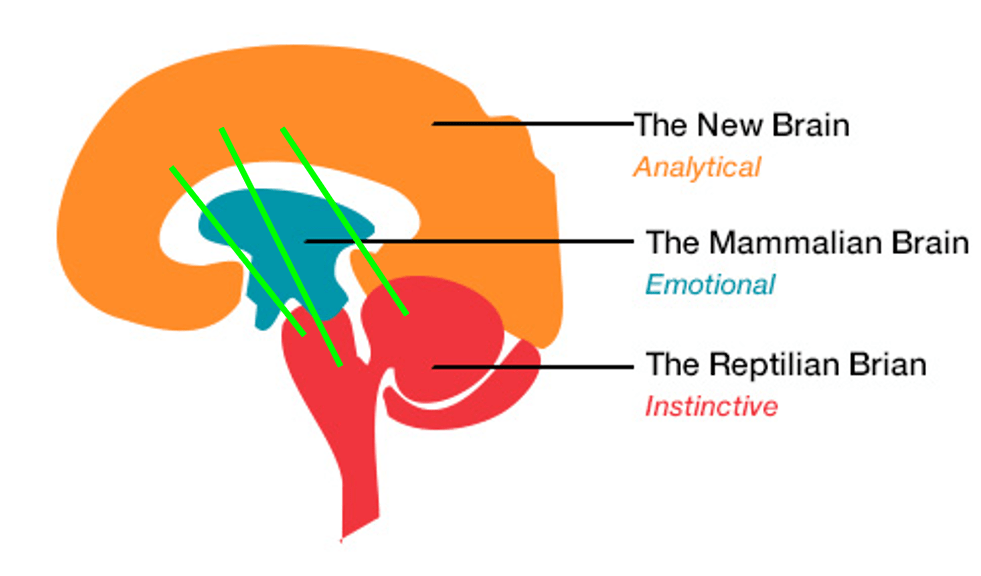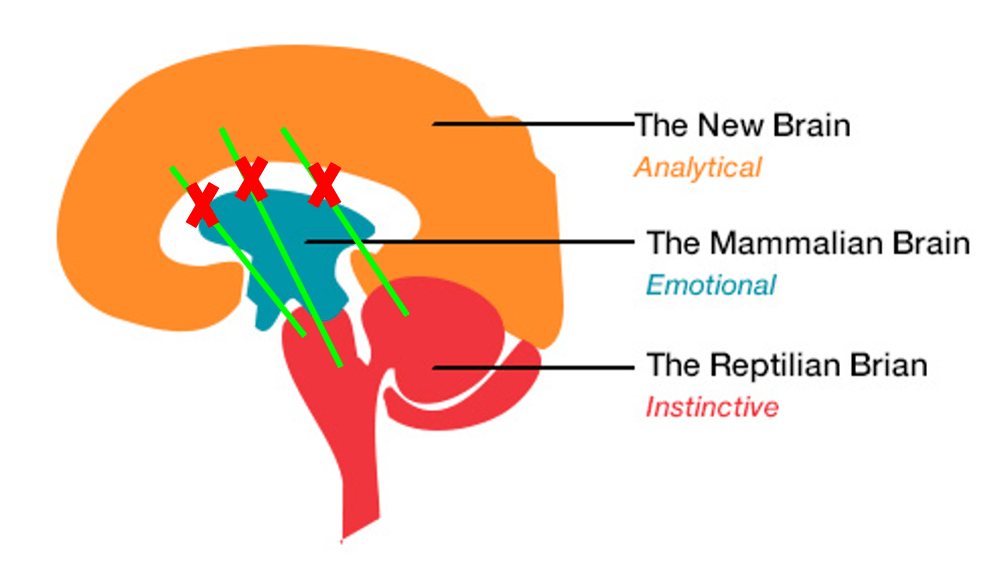Last week, I wrote an article about the neuroscience of mindsets, which suggested that our mindsets are long-range neural connections that serve as our brain’s circuit board, connecting our three primary brain regions: basal ganglia (reptilian brain), limbic system (mammalian brain), and neocortex (human brain). See the neon green lines.

Ideal Situation
In an ideal situation, these long-range neural connections allow for balanced integration between these three brain regions.
Simple Example
For example, if you see a harmless spider:
- That is going to be information that your basal ganglia is likely going to be sensitive to, filtering that information into your limbic system for further processing.
- And, if you are somewhat normal, your limbic system will create some stress-induced emotions as way to gear your body up for protecting itself.
- But, if the long-range neural connections are integrated well, your neocortex will step in and regulate your processing and body responses, allowing you to rationally tell your other brains regions: “This spider is small, there is no need to get worked up.”
Leader Mindset Situation (Open Mindset) Example
Now consider a leader whose mindsets are well-integrated across the three brain regions.
Let’s suppose this leader’s ideas are challenged by a subordinate.
- This is likely information the leader’s basal ganglia is likely going to be sensitive to, filtering that information into your limbic system for further processing.
- Next, the leader’s limbic system will likely raise a red flag warning of impending danger to one’s self and/or ego.
- But, if the leader’s long-range neural connections are integrated well, then the leader’s neocortex will step in and regulate the leader’s processing and body responses, allowing the leader to tell the other brain regions: “A challenge to my ideas is an opportunity to learn, think more optimally, and get closer to truth.”
This is the epitome of an open mindset.

What’s Going on When Someone Has Negative Mindsets
When someone has negative mindsets, it is an indication that their long-range neural connections are not well-integrated across the three brain regions.
When there is a lack of integration, what is generally going on is that the basal ganglia and limbic system play a larger and more significant role compared to the neocortex. It is almost as though the firing of these long-range neural connections doesn’t make it to the neocortex. See the red “x”’s.

Leader Mindset Situation (Closed Mindset) Example
To demonstrate, let’s go back to the example of the leader’s ideas being challenged by a subordinate
- This is likely information the leader’s basal ganglia is likely going to be sensitive to, filtering that information into your limbic system for further processing.
- Next, the leader’s limbic system will likely raise a red flag warning of impending danger to one’s self and/or ego.
- But, if the leader’s long-range neural connections are not integrated well, then the leader’s neocortex does not step in and regulate the leader’s processing and body responses.
- Thus, the basal ganglia and limbic system end up controlling the leader’s processing and operation and interprets the scenario as being unsafe. As a result, the leader will become defensive and shut down the challenge as a way to protect him or herself.
This is the epitome of a closed mindset.

What Causes People to Develop Negative Mindsets?
Understanding this, should lead us to wonder, what causes somebody’s long-range neural connections (i.e., mindsets) to become disintegrated?
The answer to this question is: Trauma.
Now, it is important to point out that there is big “T” trauma and little “t” trauma, but either affect our brain’s integration, and therefore our mindsets.
So, in the case of the leader with the open mindset, their open mindset means that they either haven’t had trauma in their lives to throw their neural connections out of whack, or they have been able to essentially “rewire” their brain.
But, in the case of the leader with the closed mindset, their closed mindset is an indication that they have been hurt before and feel a strong need to be right and seen as the authority.
There are different needs associated with the different mindsets:
- Fixed mindset – Need to look good
- Closed mindset – Need to be right
- Prevention mindset – Need to avoid problems (be safe)
- Inward mindset – Need to get ahead
Coming Up
In the next several blog posts, I want to cover my learnings on:
- The effect that trauma has on our mindsets and how we process and operate
- What science and practice suggests is the best way to establish better neural integration and more positive mindsets
Why Does This Matter?
We are trying to develop a leader whose brain isn’t integrated well, we can teach them everything under the sun about how to be a better leader, but without more healthy integration, all of that training is going to have little impact. This is because that leader’s basal ganglia and limbic system are running rampant, and the new knowledge housed in the neocortex can’t touch it.
So, if we want to see our leadership development efforts become more effective, we have got to help our leaders to become more integrated.
Want More?
If you want to learn more about the role of trauma in how people process and operate, let me recommend two incredible books:
- (Lighter content) – Mindsight: The Science of Personal Transformation by Daniel J. Siegel, M.D.
- (Deeper/richer content) – The Body Keeps the Score: Brain, Mind, and Body in the Healing of Trauma by Bessel Van Der Kolk, M.D.
If you want to focus more on the mind in your personal or leadership development efforts, reach out to me here: Connect with Ryan












One Response
I loved this! It made it much easier to understand about the various mindsets.